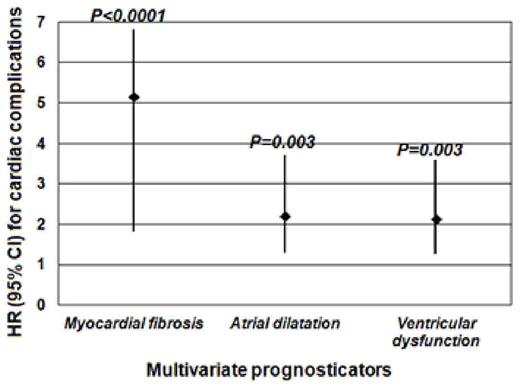Abstract
Aims. The aim of this prospective and multicentre study was toassess the predictive value of traditional and non traditional cardiovascular risk factors (CRF) and Cardiovascular Magnetic Resonance (CMR) parameters for vascular events (VE) and cardiac complications (CC) in thalassemia major (TM) patients.
Methods: We considered 957 TM patients (489 F, 30.34±8.23 years) enrolled in the Myocardial Iron Overload in Thalassemia network. Myocardial iron overload was assessed by T2* technique. Heart function was quantified by cine images. Late gadolinium enhancement (LGE) images were acquired to detect myocardial fibrosis.
Results. One-hundred and six (11.1%) patients were excludedbecause a CC was present at the baseline CMR. Mean follow-up time was 79.59±28.45 months. We recorded 13 VD (4 peripheral vascular disease, 3 PH, 3 strokes, 1 PE, 1 DVT, 1 angina). No CMR parameters predicted the development of a VD. However, patients older than 40 years showed a significant higher risk of VD than patients younger than 20 years (HR=10.13, 95%CI=1.18-86.74, P=0.035).
Arrhythmias occurred in 43 patients (40 supraventricular, 2 ventricular and 1 AV block)and heart failure in 30 patients, for a total of 86 CC. In the multivariate analysis the independent predictive factors for CC were myocardial fibrosis, atrial dilation and ventricular dysfunction (see Figure).
Conclusions: CMR by a multi-parametric approach provided prognostic information in TM patients. However, when only VE were considered, CMR lose its predicting role, while the importance of the older age emerged as significant risk factors.
Pepe: Chiesi Farmaceutici and ApoPharma Inc.: Other: Alessia Pepe is the PI of the MIOT project, that receives no profit support from Chiesi Farmaceutici S.p.A. and ApoPharma Inc.
Author notes
Asterisk with author names denotes non-ASH members.


This feature is available to Subscribers Only
Sign In or Create an Account Close Modal